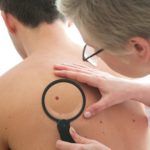Mole Check: Spotting The Signs Of Melanoma Early
Introduction: When it comes to your skin, moles are common. Most people have at least a few, and they’re usually harmless. But sometimes, a mole can be a sign of melanoma, a serious type of skin cancer. It’s important to know what to look for, so you can catch any problems early. This blog will guide you through the steps to identify suspicious moles that could potentially be melanoma.
Understanding Moles
Moles, known medically as nevi, are growths on the skin that often appear brown or black. They can develop anywhere on your body, usually until about age 40. Most moles are harmless, but some can become cancerous, making it essential to monitor changes in your skin.
The ABCDEs of Melanoma
Dermatologists use the ABCDE rule to help spot the signs of melanoma. Let’s break down what each letter means:
Asymmetry
Think of your mole as a butterfly with its wings spread out. Both sides should mirror each other perfectly when you draw an imaginary line down the center. If they don’t, and one side seems to have a different shape or size than the other, this asymmetry could be a red flag.
Border
Imagine the border of a mole as the shoreline of a calm lake; it should be smooth and regular, curving gently around the mole. If the border of your mole looks more like the rugged coast of a rough sea with jagged cliffs — uneven, notched, or blurred — it’s time to be cautious.
Color
Now, let’s think about the color of a mole like a blank canvas. Usually, a mole will be a uniform shade of brown, giving you a simple, single-color picture. However, when you start to see splashes of different colors — maybe a dab of black, a drop of blue, a hint of red, or even a spot of white — the canvas becomes more complex.
Diameter:
When considering the size of a mole, use the eraser on the end of a pencil as a reference — it’s about 6mm across. If a mole is larger than this, or if it’s growing to exceed this size, it’s similar to a plant that’s outgrowing its pot; it may be time to take action and get it evaluated.
Evolving
The evolution of a mole is perhaps the most telling sign of all. Any mole that changes over time — whether it’s in size, shape, color, or height — is like a chameleon that’s constantly changing its colors; it’s a natural wonder, but in the case of moles, it can be a serious concern.
High-Risk Factors
Some people are at higher risk of melanoma than others. Risk factors include having a fair complexion, a history of sunburns, excessive UV exposure, lots of moles or a few large moles, a history within your family of skin cancer, or a weakened immune system.
Regular Self-Exams
Checking your own skin can lead to early detection and a high chance of successful treatment. Perform a thorough skin check monthly. Get familiar with your moles’ location and appearance so you can notice any changes quickly.
When to See a Dermatologist
If you spot any changes in a mole using the ABCDE rule or have high-risk factors, make an appointment with a dermatologist. They can perform a more detailed skin exam and decide if a biopsy is necessary.
Preventative Measures
While identifying potentially cancerous moles is crucial, prevention is just as important. Use sunscreen, wear protective clothing, and avoid peak sun hours. Remember, skin protection is a daily commitment.
Being aware of the signs of melanoma can save your life. If you’re concerned about a mole or your skin health, don’t hesitate. Contact us at East Carolina Dermatology and Skin Surgery, PLLC to schedule a skin examination today. It’s always better to be safe and get your moles checked by a professional who can provide peace of mind or early treatment if necessary.










